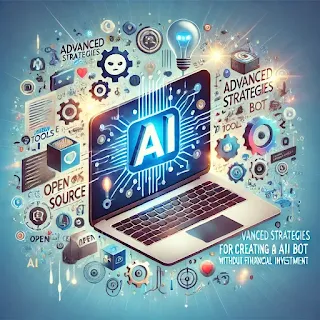Advanced Strategies for Creating a Custom AI Bot Without Financial Investment 2025.
Advanced Strategies for Creating a Custom AI Bot Without Financial Investment
Artificial Intelligence (AI) continues to revolutionize industries globally, presenting unparalleled opportunities for automation, problem-solving, and enhanced user engagement. Designing a custom AI bot, even without incurring any cost, is now more achievable than ever. This guide delves into the intricate processes, tools, and strategies necessary for crafting a sophisticated AI bot tailored to specific needs.
Conceptual Foundations of AI Bot Development
Before embarking on bot creation, it is imperative to grasp the foundational components underpinning AI bot functionality:
Input Processing: Capturing and analyzing user queries to discern intent and context.
Natural Language Processing (NLP): Employing advanced techniques to interpret and generate human-like text, thereby facilitating intuitive interactions.
Response Generation: Synthesizing coherent, actionable replies tailored to user demands.
Integration: Seamlessly deploying the bot across various platforms such as websites, mobile applications, or messaging systems to ensure accessibility and functionality.
These core elements constitute the architecture of an AI bot, underscoring its operational efficiency and user-centric design.
Comprehensive Guide to Building a Cost-Free AI Bot
1. Establishing the Bot's Objectives
A successful AI bot begins with a clearly defined purpose. Articulate the bot's primary functions and target audience. Typical use cases include:
Customer Support: Addressing inquiries and resolving issues around the clock.
Lead Generation: Capturing and qualifying potential customers with efficiency.
Automated Scheduling: Facilitating appointments or event planning seamlessly.
A well-defined objective aligns development efforts with user expectations and organizational goals.
2. Selecting a Free AI Platform
Numerous platforms empower users to create AI bots without requiring advanced technical skills. Among the most prominent are:
Dialogflow by Google: Renowned for its natural language understanding capabilities and ease of integration.
Microsoft Bot Framework: A versatile suite of tools enabling the design, testing, and deployment of bots across multiple channels.
Tidio: Specializes in customer service applications with intuitive setup processes.
Botpress: An open-source platform that offers extensive customization for developers.
Each platform's free tier provides sufficient resources to construct functional prototypes and refine interactions.
3. Designing the Conversational Architecture
The conversational flow forms the backbone of the bot's user experience. Employ tools like Lucidchart or integrated features within platforms such as Dialogflow to design:
User Interaction Scenarios: Anticipate a broad spectrum of user queries.
Structured Responses: Create contextually appropriate and dynamic replies.
Decision Trees: Develop pathways to navigate complex, multi-turn conversations.
A meticulously planned conversational flow ensures clarity, coherence, and responsiveness in user interactions.
4. Incorporating Advanced NLP Capabilities
Enhancing your bot’s linguistic proficiency involves integrating advanced Natural Language Processing libraries. Widely used open-source tools include:
NLTK (Natural Language Toolkit): A comprehensive library for textual data preprocessing and linguistic analysis.
spaCy: Praised for its efficiency in handling large-scale text processing tasks.
Hugging Face Transformers: Provides state-of-the-art pre-trained models, readily adaptable for domain-specific applications.
Such tools enable your bot to handle nuanced queries, improving conversational depth and accuracy.
5. Leveraging Pre-Trained Models for Efficiency
Harnessing pre-trained AI models significantly reduces development time while enhancing capabilities. Platforms like OpenAI's ChatGPT API and Hugging Face allow access to sophisticated models that can be customized to meet specific requirements.
Example: A healthcare-oriented bot can utilize a pre-trained medical NLP model and refine it with specialized datasets for enhanced diagnostic accuracy.
6. Rigorous Testing and Refinement
Thorough testing is critical to ensure the bot operates seamlessly under diverse scenarios. The testing process includes:
Alpha Testing: Internal evaluations to identify and resolve functional anomalies.
Beta Testing: Engaging external users to gather actionable feedback.
Iterative Enhancement: Continuously refining the bot based on performance insights and user recommendations.
This iterative approach guarantees reliability and adaptability in real-world deployments.
7. Deploying the Bot Across Free Channels
Deployment determines the bot’s accessibility to its intended audience. Free deployment options include:
Facebook Messenger: A powerful platform for customer engagement.
WhatsApp Business (via free-tier Twilio): Facilitates interactive real-time communication.
Embedded Web Widgets: Enhances website functionality with chat integration.
Telegram Bots: Popular for automation and user interaction in diverse applications.
Each platform provides detailed documentation to streamline integration.
8. Monitoring and Continuous Optimization
Post-deployment monitoring is essential to maintain and improve performance. Utilize free analytics tools like Google Analytics or platform-specific dashboards to track:
User Engagement Metrics: Assess interaction frequency and quality.
Accuracy of Responses: Identify inconsistencies and refine algorithms.
User Feedback Trends: Address emerging issues and improve user satisfaction.
Regular updates and optimization ensure the bot evolves alongside user needs.
Advanced Techniques for AI Bot Creation
Leveraging Open-Source Frameworks
Frameworks like Rasa and Botpress provide unparalleled flexibility for developers, enabling complete customization without licensing constraints.
Utilizing APIs for Enhanced Functionality
Incorporate APIs to expand the bot’s capabilities. For example:
Weather APIs: Deliver real-time weather updates.
Currency Conversion APIs: Facilitate financial transactions and analysis.
Free Hosting Solutions
Platforms such as Heroku, Replit, and GitHub Pages offer robust, no-cost hosting solutions, ensuring scalability and reliability.
Applications of Cost-Free AI Bots
Customer Support Automation: Efficiently handle FAQs and complex queries.
Educational Tools: Provide personalized learning and instant tutoring assistance.
Lead Qualification Systems: Streamline the process of identifying high-value prospects.
Event Management: Simplify registrations, updates, and attendee interactions.
Conclusion
Designing a custom AI bot without financial expenditure is a realistic and highly rewarding endeavor. By leveraging freely available platforms, open-source tools, and pre-trained models, individuals and organizations can harness the transformative potential of AI. Following the strategies outlined in this guide will empower you to develop, deploy, and optimize a high-quality AI bot that aligns with user expectations and drives value.


Comments
Post a Comment